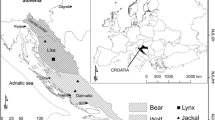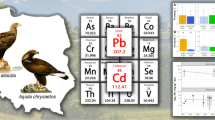Abstract
Concentrations of 20 trace elements (V, Cr, Mn, Co, Cu, Zn, Rb, Sr, Mo, Ag, Cd, In, Sn, Sb, Cs, Ba, Hg, Tl, Pb, and Bi) were measured in livers of polar bears (Ursus maritimus) collected from Northern and Western Alaska from 1993 to 2002 to examine differences in the profiles of trace metals between the Beaufort Sea (Northern Alaska) and the Chukchi Sea (Western Alaska) subpopulations in Alaska. Among the trace elements analyzed, concentrations of Cu (50–290 µg/g, dry wt) in polar bear livers were in the higher range of values that have been reported for marine mammals. Concentrations of Hg in polar bears varied widely, from 3.5 to 99 µg/g dry wt, and the mean concentrations in polar bears were comparable to concentrations reported previously for several other species of marine mammals. Mean concentrations of Pb and Cd were 0.67 and 1.0 µg/g dry wt, respectively; these concentrations were lower than levels reported elsewhere for polar bears from Greenland and Canada. Age- and gender-related variations in the concentrations of trace elements in our polar bears were minimal. Concentrations of Hg decreased slowly in samples collected during 1993–2002, whereas Cd and Pb concentrations were found to be stable or slowly increasing, in the livers of Alaskan polar bears. Concentrations of Ag, Bi, Ba, Cu, and Sn were significantly higher in the Chukchi Sea subpopulation than in the Beaufort Sea subpopulation. Concentrations of Hg were significantly higher in the Beaufort Sea subpopulation than in the Chukchi Sea subpopulation. Differences in the profiles and concentrations of Hg, Ag, Bi, Ba, Cu, and Sn suggest that the sources of exposure to these trace elements between Western and Northern Alaskan polar bears are different, in agreement with findings reported earlier for several organic contaminants.







Similar content being viewed by others
References
Agusa T, Matsumoto T, Ikemoto T, Anan Y, Kubota R, Yasunaga G, Kunito T, Tanabe S, Ogi H, Shibata Y (2005) Body distribution of trace elements in black-tailed gulls from Rishiri Island, Japan: age-dependent accumulation and transfer to feathers and eggs. Environ Toxicol Chem 24:2107–2120
AMAP (2005) AMAP Assessment 2002: Heavy metals in the Arctic. Arctic Monitoring and Assessment Programme (AMAP), Oslo, Norway
Amstrup SC, McDonald TL, Durner GM (2004) Using satellite radiotelemetry data to delineate and manage wildlife populations. Wildlife Soc Bull 32:661–679
Amstrup SC, Durner GM, Stirling I, McDonald TL (2005) Allocating harvests among polar bear stocks in the Beaufort Sea. Arctic 58:247–259
Anan Y, Kunito T, Ikemoto T, Kubota R, Watanabe I, Tanabe S, Miyazaki N, Petrov EA (2002) Elevated concentrations of trace elements in Caspian seals (Phoca caspica) found stranded during the mass mortality events in 2000. Arch Environ Contam Toxicol 42:354–362
Anan Y, Kunito T, Watanabe I, Sakai H, Tanabe S (2001) Trace element accumulation in hawksbill turtle (Eretmochelys imbricata) and green turtle (Chelonia mydas) from Yaeyama Islands, Japan. Environ Toxicol Chem 20:2802–2814
Asante KA, Agusa T, Subramanian A, Ansa-Asare OD, Biney CA, Tanabe S (2007) Contamination status of arsenic and other trace elements in drinking water and residents from Tarkwa, a historic mining township in Ghana. Chemosphere 66:1513–1522
Becker PR, Mackey EA, Schantz MM, Greenberg RR, Koster BJ, Wise SA, Muir DCG (1995) Concentrations of chlorinated hydrocarbons, heavy metals and other elements in tissues banked by the Alaska Marine Mammal Tissue Archival Project, NISTIR 5620, National Institute of Standards and Technology, Gaithersburg, MD
Braune BM, Mallory ML, Gilchrist HG (2006) Elevated mercury levels in a declining population of ivory gulls in the Canadian Arctic. Marine Pollut Bull 52:969–987
Bustamante P, Garrigue C, Breau L, Caurant F, Dabin W, Greaves J, Dodemont R (2003) Trace elements in two odontocete species (Kogia breviceps and Globicephala macrorhynchus) stranded in New Caledonia (South Pacific). Environ Pollut 124:263–271
Calvert W, Ramsay M (1998) Evaluation of age determination of polar bears by counts of cementum growth layer groups. Ursus 10:449–453
Das K, Debacker V, Bouquegneau JM (2000) Metallothioneins in marine mammals. Cell Mol Biol 46:283–294
Das K, Holsbeek L, Browning J, Siebert U, Birkun A Jr, Bouquegneau J-M (2004) Trace metal and stable isotope measurements (δ13C and δ15N) in the harbour porpoise Phocoena phocoena relicta from the Black Sea. Environ Pollut 131:197–204
Dietz R, Riget F, Born EW (2000a) Geographical differences in zinc, cadmium, mercury and selenium in polar bears (Ursus maritimus) from Greenland. Sci Total Environ 245:25–47
Dietz R, Riget F, Born EW (2000b) An assessment of selenium to mercury in Greenland marine mammals. Sci Total Environ 245:15–24
Dietz R, Riget F, Born EW, Sonne C, Grandjean P, Kirkegaard M, Olsen MT, Asmund G, Renzoni A, Baagoe H, Andreasen C (2006) Trends in mercury in hair of Greenlandic polar bears (Ursus maritimus) during 1892–2001. Environ Sci Technol 40:1120–1125
Evans TJ, Fischbach A, Schliebe S, Manly B, Kalxdorff S, York G (2003) Polar bear aerial survey in the eastern Chukchi Sea: a pilot study. Arctic 56:359–366
Gerlach SC, Duffy LK, Murray MS, Bowers PM, Adams R, Verbrugge DA (2006) An exploratory study of total mercury levels in archaeological caribou hair from northwest Alaska. Chemosphere 65:1909–1914
Ichihashi H, Kohno H, Kannan K, Tsumura A, Yamasaki S (2001) Multielemental analysis of purpleback flying squid using high resolution inductively coupled plasma–mass spectrometry (HRICP-MS). Environ Sci Technol 35:3103–3108
Ikemoto T, Kunito T, Watanabe I, Yasunaga G, Baba N, Miyazaki N, Petrov EA, Tanabe S (2004) Comparison of trace element accumulation in Baikal seals (Pusa sibirica), Caspian seals (Pusa caspica) and northern fur seals (Callorhinus ursinus). Environ Pollut 127:83–97
Kannan K, Agusa T, Perrotta E, Thomas NJ, Tanabe S (2006) Comparison of trace element concentrations in livers of diseased, emaciated, and non-diseased southern sea otters from the California coast. Chemosphere 65:2160–2167
Kannan K, Yun SH, Evans TJ (2005) Chlorinated, brominated and perfluorinated contaminants in livers of polar bears from Alaska. Environ Sci Technol 39:9057–9063
Kunito T, Nakamura S, Ikemoto T, Anan Y, Kubota R, Tanabe S, Rosas FCW, Fillmann G, Readman JW (2004) Concentration and subcellular distribution of trace elements in liver of small cetaceans incidentally caught along the Brazilian coast. Marine Pollut Bull 49:574–587
Kunito T, Watanabe I, Yasunaga G, Fujise Y, Tanabe S (2002) Using trace elements in skin to discriminate the populations of minke whales in southern hemisphere. Marine Environ Res 53:175–197
Lam JCW, Tanabe S, Chan SKF, Yuen EKW, Lam MHW, Lam PKS (2004) Trace element residues in tissues of green turtles (Chelonia mydas) from South China waters. Marine Pollut Bull 48:164–192
Law RJ (1996) Metals in marine mammals. In: Beyer WN, Heinz GH, Redmon-Norwood AW (eds) Environmental contaminants in wildlife: Interpreting tissue concentrations. CRC Press, Boca Raton, FL, pp 357–376
Law RJ, Jones BR, Baker JR, Kennedy S, Milne R, Morris RJ (1992) Trace metals in the livers of marine mammals from the Welch coast and Irish Sea. Marine Pollut Bull 24:296–304
Law RJ, Morris RJ, Allchin CR, Jones BR, Nicholson MD (2003) Metals and organochlorines in small cetaceans stranded on the east coast of Australia. Marine Pollut Bull 46:1200–1211
Leitch DR, Carrie J, Lean D, Macdonald RW, Stern GA, Wang F (2007) The delivery of mercury to the Beaufort Sea of the Arctic Ocean by the Mackenzie River. Sci Total Environ 373:178–195
Mackey EA, Oflaz RD, Epstein MS, Buehler B, Porter BJ, Rowles T, Wise SA, Becker PR (2003) Elemental composition of liver and kidney tissues of rough-toothed dolphins (Steno bredanensis). Arch Environ Contam Toxicol 44:523–532
Meador JP, Ernest D, Hohn AA, Tilbury K, Gorzelany J, Worthy G, Stein JE (1999) Comparison of elements in bottlenose dolphins stranded on the beaches of Texas and Florida in the Gulf of Mexico over a one-year period. Arch Environ Contam Toxicol 36:87–98
Muir D, Braune B, DeMarch B, Norstrom R, Wagemann R, Lockhart L, Hargrave B, Bright D, Addison R, Payne J, Reimer K (1999) Spatial and temporal trends and effects of contaminants in the Canadian Arctic marine ecosystem: a review. Sci Total Environ 230:83–144
Paludan MP, Agger CT, Dietz R, Kinze CC (1993) Mercury, cadmium, zinc, copper and selenium in habour porpoise (Phocoena phocoena) from west Greenland. Polar Biol 13:311–320
Ruelas-Inzunza J, Páez-Osuna F (2002a) Distribution of Cd, Cu, Fe, Mn, Pb and Zn in selected tissues of juvenile whales stranded in the SE Gulf of California (Mexico). Environ Int 28:325–329
Ruelas-Inzunza J, Páez-Osuna F (2002b) Distribution of cadmium, copper, iron, manganese, lead, and zinc in spinner dolphins Stenella longirostris stranded in La Paz Lagoon, Southwest Gulf of California. Bull Environ Contam Toxicol 69:408–414
Senthilkumar K, Kannan K, Corsolini S, Evans T, Giesy JP, Nakanishi J, Masunaga S (2002) Polychlorinated dibenzo-p-dioxins, dibenzofurans and polychlorinated biphenyls in polar bear, penguin and south polar skua. Environ Pollut 119:151–161
Szefer P, Zdrojewska I, Jensen J, Lockyer C, Skora K, Kuklik I, Malinga M (2002) Intercomparison studies on distribution and coassociations of heavy metals in liver, kidney, and muscle of harbor porpoise, Phocoena phocoena, from southern Baltic Sea and coastal waters of Denmark and Greenland. Arch Environ Contam Toxicol 42:508–522
Wagemann R, Innes S, Richard PR (1996) Overview and regional and temporal differences of heavy metals in Arctic whales and ringed seals in the Canadian Arctic. Sci Total Environ 186:41–66
Woshner VM, O’Hara TM, Brattton GR, Beasley VR (2001) Concentrations and interactions of selected essential and non-essential elements in ringed seals and polar bears of Arctic Alaska. J Wildl Dis 37:711–721
Zhou JL, Salvador SM, Liu YP, Sequeira M (2001) Heavy metals in the tissues of common dolphins (Delphinus delphis) stranded on the Portugese coast. Sci Total Environ 273:61–76
Acknowledgments
A portion of the study was supported by a grant from “21st Century Center for Excellence (COE) Program” from the Ministry of Education, Culture, Sports, Science and Technology, Japan. We thank the native subsistence hunters for providing samples for this study.
Author information
Authors and Affiliations
Corresponding author
Rights and permissions
About this article
Cite this article
Kannan, K., Agusa, T., Evans, T.J. et al. Trace Element Concentrations in Livers of Polar Bears from Two Populations in Northern and Western Alaska. Arch Environ Contam Toxicol 53, 473–482 (2007). https://doi.org/10.1007/s00244-007-0018-x
Received:
Accepted:
Published:
Issue Date:
DOI: https://doi.org/10.1007/s00244-007-0018-x




